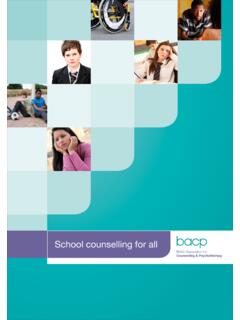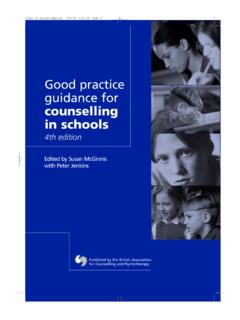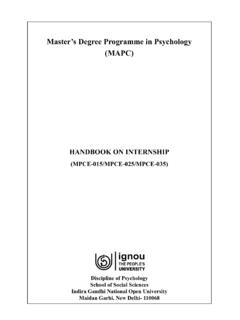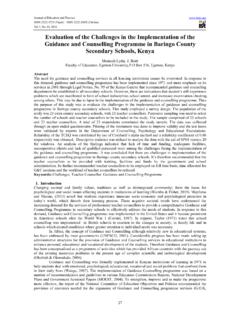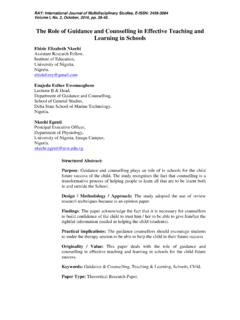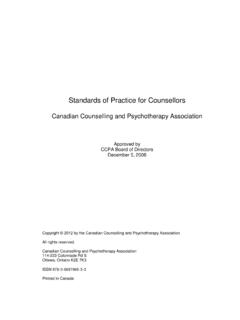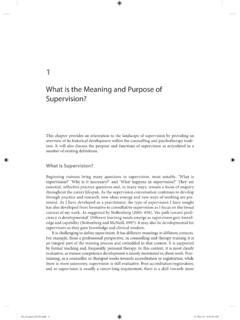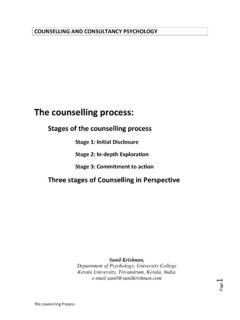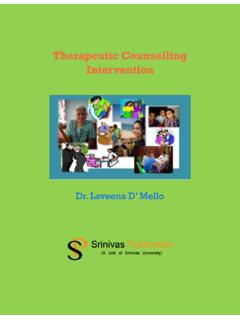Transcription of Counselling in schools: a blueprint for the future
1 Counselling in schools: a blueprint for the future Departmental advice for school leaders and counsellors February 2016. Contents Summary 4. About this departmental advice 4. Expiry or review date 4. Who is this advice for? 4. 1. Introduction 6. 2. Current situation 8. Approaches to service delivery 8. 3. future expectations for school based Counselling 11. 4. Whole school context 12. Improving wellbeing and resilience 12. Raising awareness of mental health through the curriculum 12. Promoting staff health and wellbeing 13. Reducing the stigma around mental health 13. Interaction with the pastoral system 14.
2 Leadership role 15. 5. What is Counselling and how can it help children and young people? 17. How can school based Counselling help children and young people? 17. 6. Using counsellors in schools practical issues 20. Decisions to employ or contract counsellors 20. Funding school counsellors 20. Models of delivery of school based Counselling 21. Line management and supervision 22. Quality assurance and impact assessment 23. 7. Counselling in practice 24. Delivery options 24. Identifying pupils in need of support 25. Appointment systems 26. Vulnerable children 28. Children with diverse identities and backgrounds 28.
3 Children and young people with Special Educational Needs and Disabilities (SEND) 28. 2. Looked after children and children adopted from care 29. Counselling environment 30. Confidentiality 30. Referral systems (from school to external agencies) 31. Working with external specialists and information sharing 32. Annex 1 34. Views of children and young people 34. What do you think Counselling is and what is it for? 34. What are your views on Counselling ? 34. Why do you think young people might need to see a counsellor? 35. Who should be a counsellor? 35. What do you think the barriers to accessing Counselling are?
4 36. How do you think we can overcome these barriers? 36. Do you think all schools should have a Counselling service? 36. What are the important features of a counsellor and Counselling service? 36. Other comments 37. Further information 38. Useful resources and external organisations 38. Other relevant departmental advice and statutory guidance 38. 3. Summary About this departmental advice This is departmental advice from the Department for Education (DfE). This advice is non- statutory, and has been produced to help school leaders set up and improve Counselling services in primary and secondary schools.
5 It provides practical, evidence-based advice informed by experts on how to ensure school based Counselling services achieve the best outcomes for children and young people. It also sets out the Government's expectation that over time we would expect to see all schools providing access to Counselling services . It is equally relevant for schools with Counselling services and those that currently have no access to them. It reflects views of children and young people on Counselling , as well as those of schools. It recognises that effective Counselling is part of a whole school approach to mental health and wellbeing.
6 This advice provides practical help for setting up or improving existing Counselling services , covering issues such as decisions around employing or contracting counsellors , funding, models of delivery, line management and quality assurance. For the many schools that already have Counselling services in place, this advice sets out areas where improvements can be made to ensure services are of high quality, delivering value for money and improved outcomes for children and young people. While the main focus is on school based Counselling , this advice also explains how Counselling fits within a whole school approach to mental health and wellbeing, covering issues such as improving wellbeing and resilience, raising awareness of mental health issues through the curriculum, reducing the stigma around mental health, effectiveness of the pastoral system and the role of leadership.
7 It is important to note that Counselling is not the only effective method to supporting mental health and emotional wellbeing in schools. This document only deals with school Counselling . Consideration of other forms of help are beyond the scope of this document, but it should be read alongside the DfE guidance on Behaviour and Mental Health, and the PSHE Association's advice and lesson plans on teaching about mental health. Expiry or review date This advice will next be reviewed in February 2017. Who is this advice for? All primary and secondary school leaders including headteachers and governing bodies as well as those with day-to-day responsibility for mental health issues in schools, counsellors , clinical supervisors, and managers of school Counselling services .
8 It will also 4. be of interest to providers and NHS and Local Authority commissioners of Counselling and other forms of psychological support. 5. 1. Introduction The Government is committed to improving children and young people's mental health and wellbeing. While mental health issues are relatively common, with around 10% of 5 to 16 year old pupils experiencing them 1, children and young people do not always get the help that they need as quickly as they should. Issues such as anxiety, low mood, depression, conduct and eating disorders can impact significantly on their happiness and future life chances.
9 The Government established a Children and Young People's Mental Health and Wellbeing Taskforce, led by the Department of Health and NHS England, working closely with other Departments, including DfE, in September 2014. This looked at ways to make it easier for children and young people and their families to access help and support when needed, and improve the way in which mental health services are organised and provided. In parallel with the work of the Taskforce, DfE announced in November 2014. that it would develop a Counselling strategy and new PSHE Association guidance on teaching about mental health issues.
10 future in Mind, the Government report of the Children and Young People's Mental Health and Wellbeing Taskforce recognises the crucial role that schools can play, working alongside health and community and voluntary services , in helping to support good mental health and in preventing and identifying mental health issues in children and young people. Most schools attach considerable importance to ensuring pupils'. wellbeing, developing character and resilience and supporting pupils with problems. They increasingly play a valuable role in early intervention and support for mental health issues, in particular through growing use of school based counsellors .










